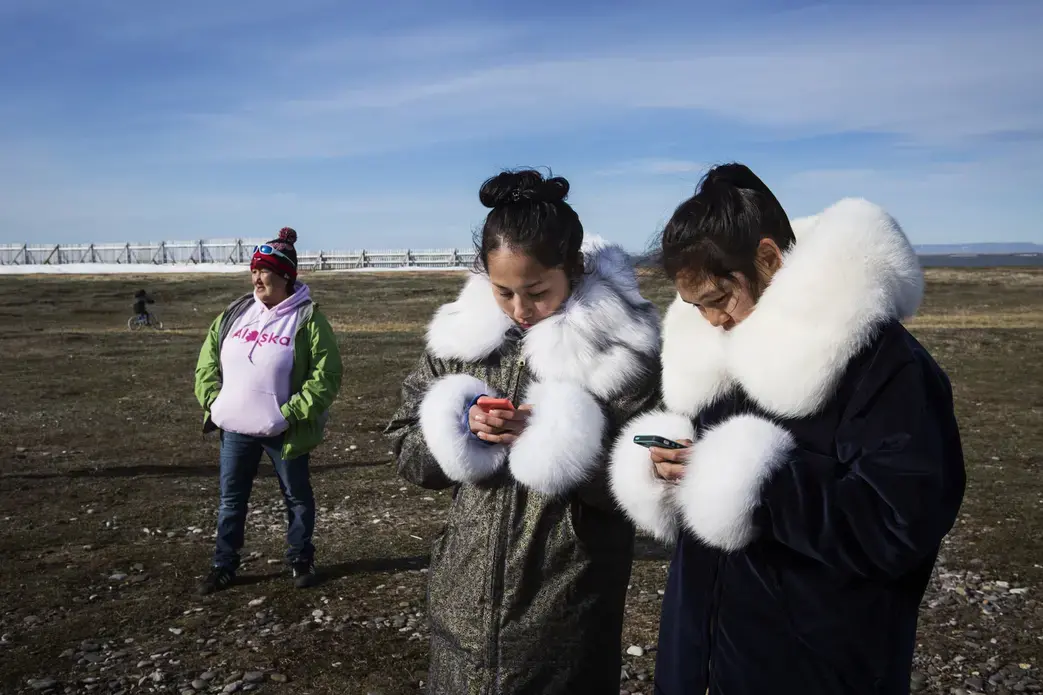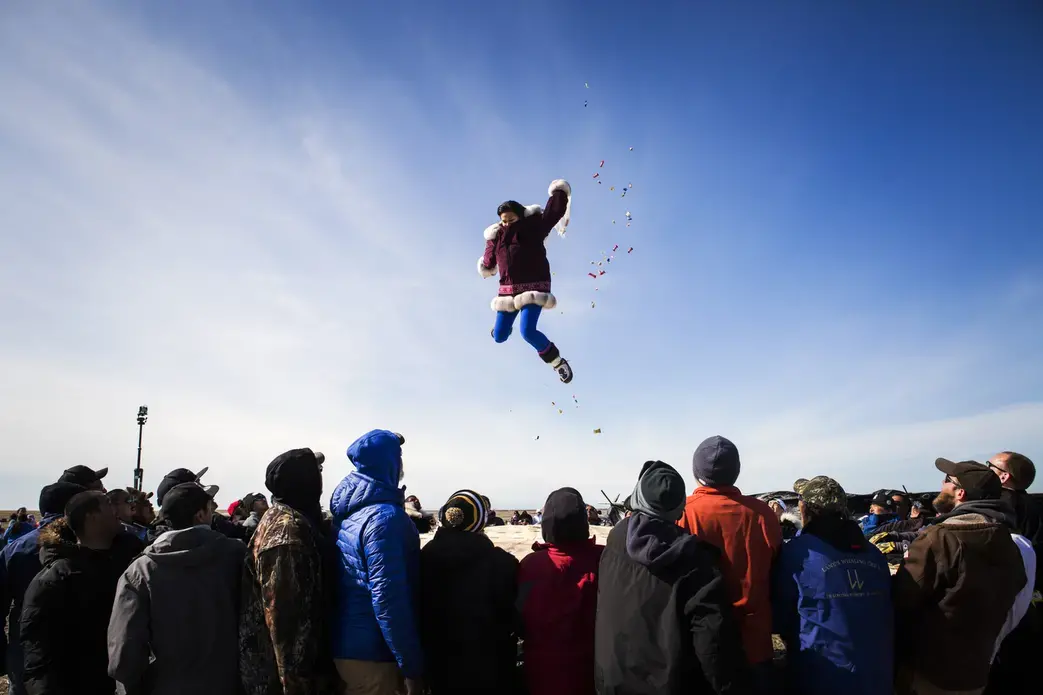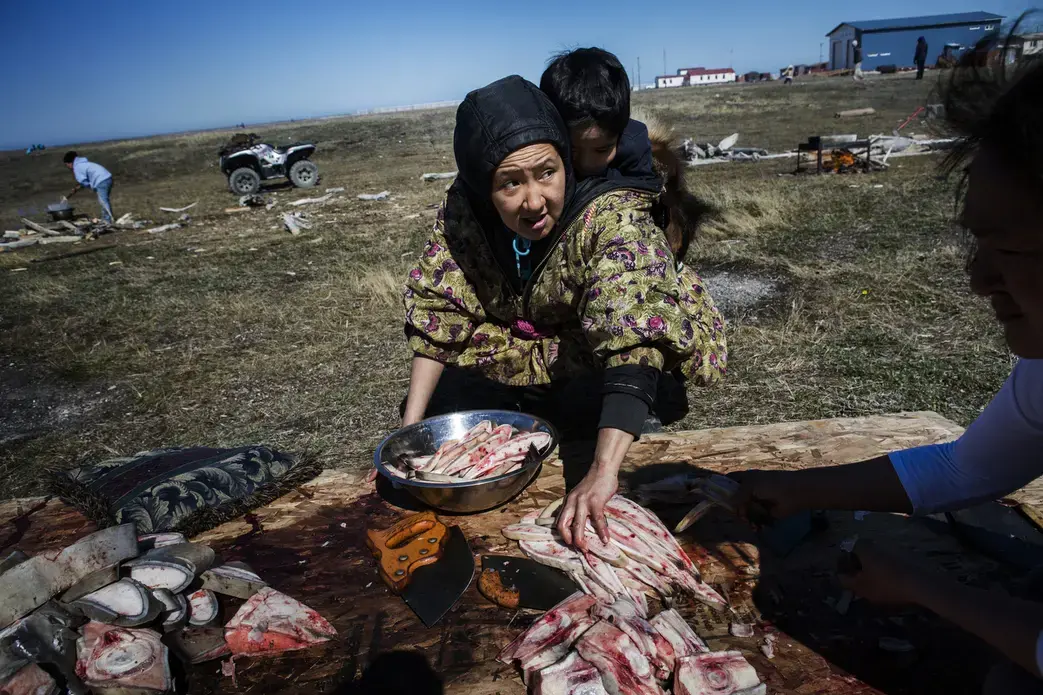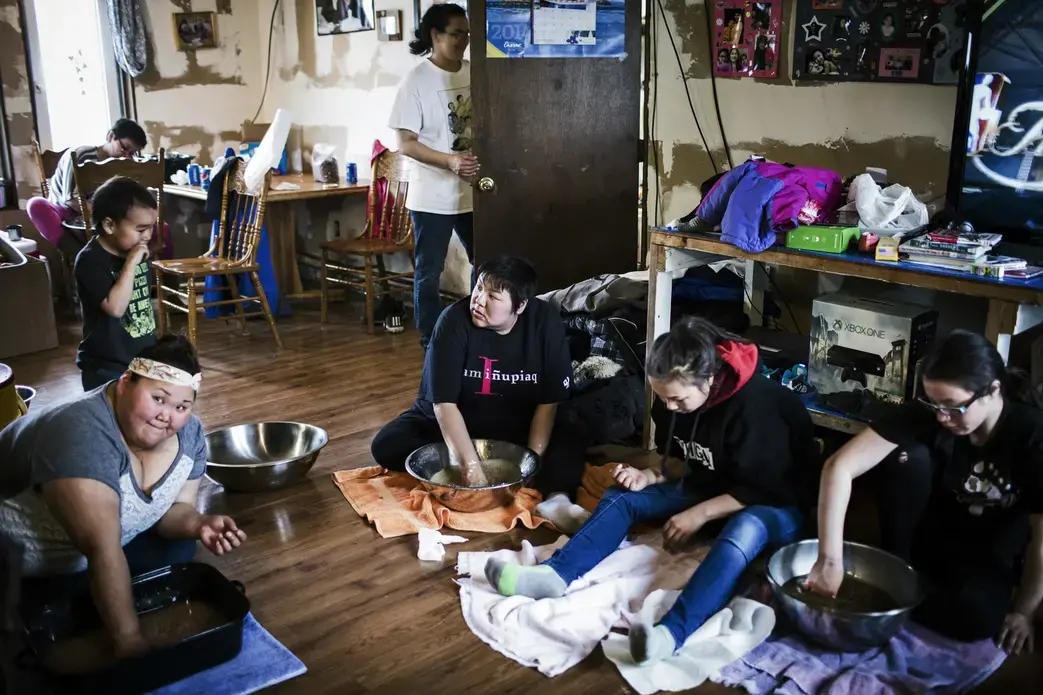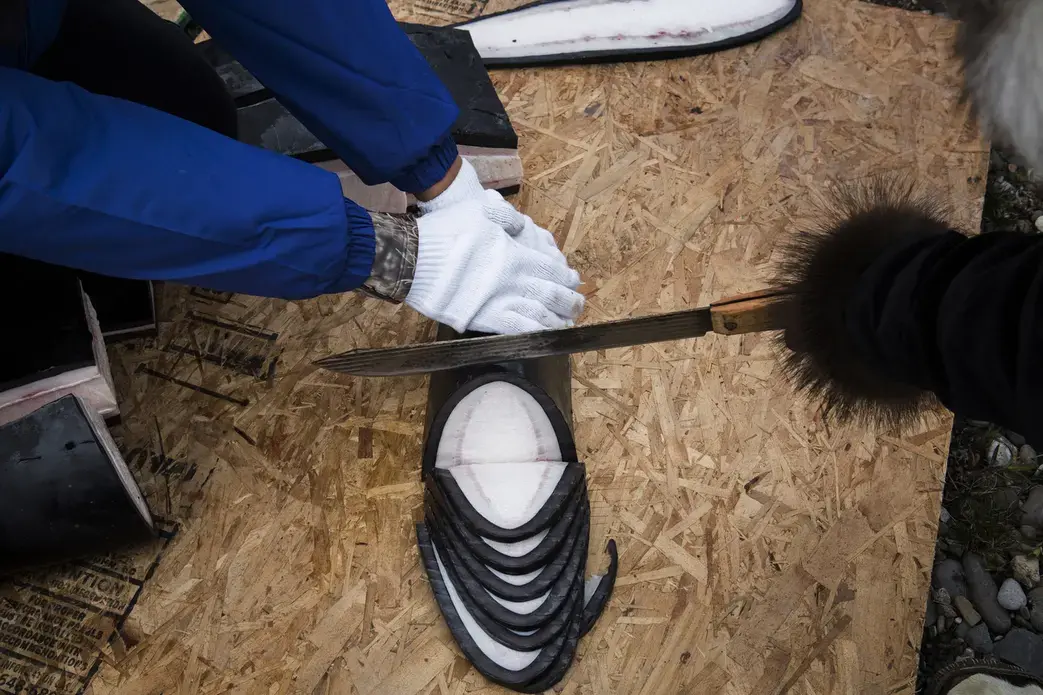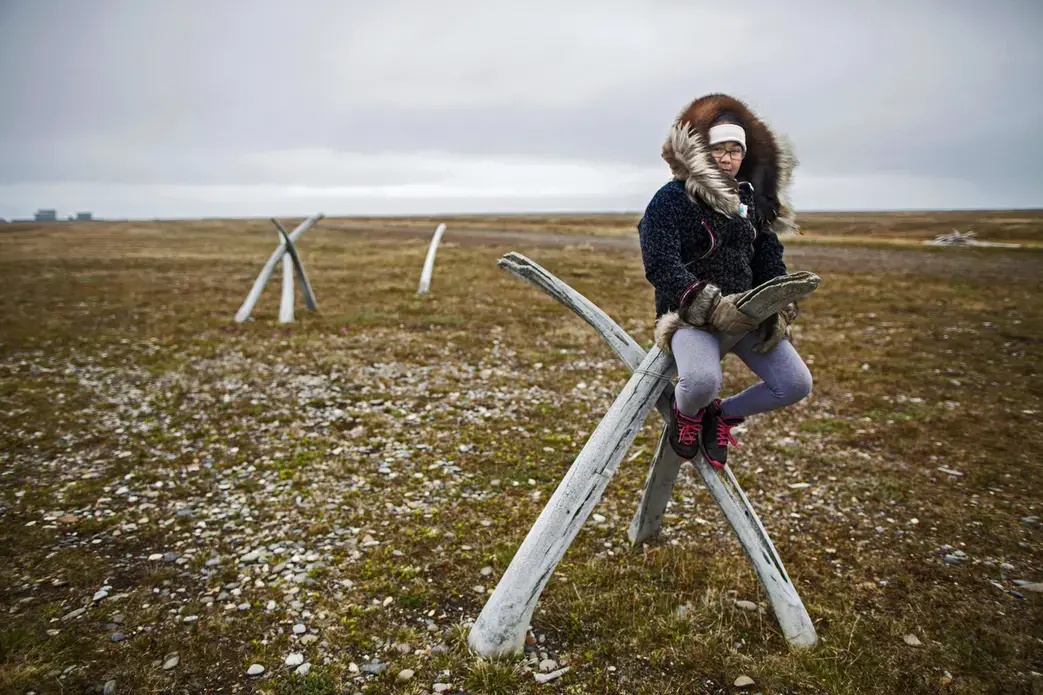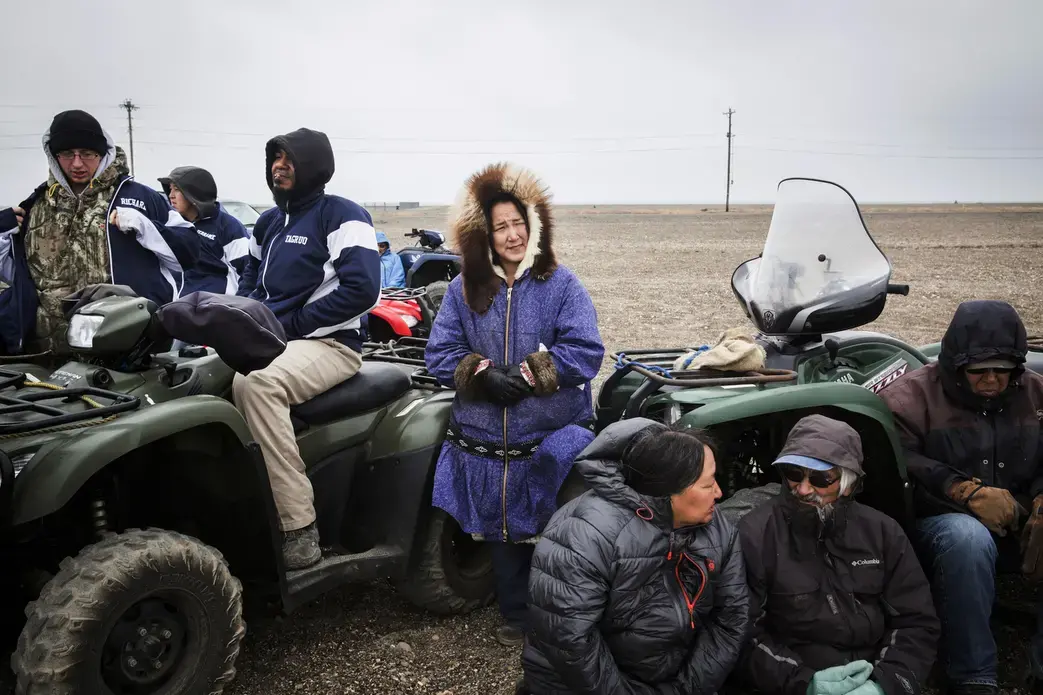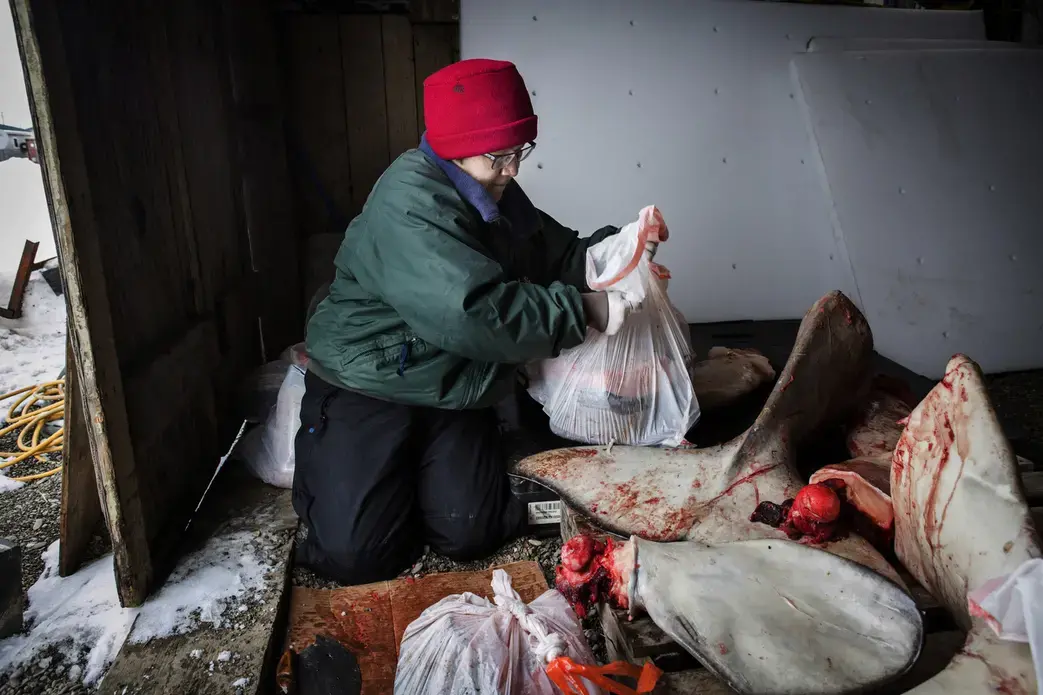For the Inupiat villagers who have made their homes on this finger of land in the Chukchi Sea for generations, nothing is more important than the bowhead whale.
The calendar revolves around seasons for hunting, fishing and gathering. It's a lifestyle Alaskans call "subsistence", which is as much cultural tradition as economic necessity in one of the state's most northern villages.
About 900 people live in Point Hope. The village store prices are double what people pay 700 miles south in Anchorage. A gallon of milk might be $12. Two pounds of hamburger patties: $23. In most homes, wild and foraged foods make up at least half of the menu. The village has two stores, a school, several churches and a restaurant that serves pizza, Chinese food and hamburgers. Alcohol can't be legally possessed, sold or imported.
All year, the village looks forward to spring whaling, when crews of men thread through leads in the sea ice, quietly paddling in seal-skin boats, looking for smooth black shapes rising out of the water.
The few massive bowheads taken by villagers each year supply thousands of pounds of dense protein. Beyond that, whale meat is considered an Alaska Native soul food. Hunting, butchering and distributing the animal, village leaders say, is how elders teach young people the culture.
"Without the whale," said Steve Oomittuk, the former mayor of the city and former vice-president of the tribe, "we wouldn't be who we are."
In recent years, however, the much-anticipated whale hunt has run up against a warming Arctic. A bowhead can be 60 feet long and weigh 75 tons. Successful whaling crews have always hauled the massive animals on to the ice using a block and tackle. The last few seasons, the ice has been more unstable than elders in the village have ever seen.
"It's getting harder and harder, the ice is thinner," Oomittuk said. "We can't pull up the whale."
Alaska had the hottest year on record in 2014, and this summer's temperatures have been above normal across the state. In the Point Hope region, spring and summer temperatures have been on a warming trend since the 1980s. What are now average summer temperatures would have been close to record-high temperatures in the mid-20th century, according to Rick Thoman, climate science and services manager for the National Weather Service in Alaska.
The experience of hunters in Point Hope is part of larger story being told by Alaska Natives in villages that rely on subsistence foods. Animal behavior is changing as the climate warms, and the windows of opportunity for certain types of hunting and fishing are shrinking.
Lack of snow last winter grounded hunters for weeks because they couldn't travel by snowmobile. Changing ice conditions have complicated the walrus hunt so deeply, they've caused food shortages in some areas. Water has been creeping into ice cellars carved generations ago in what used to be permanently frozen ground, causing meat stored there to go bad. Meat and fish drying outside have been spoiled by rain.
"It's about more than just meat," said Nicole Braem, who studies subsistence activities in the region for the state of Alaska. "Traditional culture, language, all that stuff is at its strongest point with subsistence."
Alaska Native cultures have adapted plenty over time and will continue to adapt, but climate change has become a formidable challenge to how people are used to getting their food in parts of Alaska, she said.
"The 24-hour daylight was a chance for us to hunt and gather all the different foods that migrate up north before the winter comes," Oomittuk said. "We see animals coming earlier, we see animals coming later, we see animals not coming at all. It has changed very fast."
Point Hope took three whales this year. In June at the annual feast to celebrate the harvest, elders sipped coffee and ate homemade donuts. Ron Oviok Sr, 72, sat under a skin boat turned sideways to block the wind, going over the times he'd helped bring in a whale.
"Today the ice conditions are pretty bad because of climate change," he said.
***
He can taste that whale meat kept in ice cellars is not staying as cold as it once did. Would grandchildren be able to continue the whale hunt as it had always been? Would great-grandchildren still have a taste for the meat? These questions, he couldn't answer.
"We try to keep the culture going as best we can," he said. "I'm glad hunters never give up."
Point Hope's people remain faithful to many long-held traditions. The town is still separated into two clans, each with its own whaling crews. Whaling feast activities happen at the same time every year, in two spots on either edge of town, each place designated for a different clan.
When a whaling captain is successful, he distributes meat to his family, the families of the whaling crews and the community right after the hunt and during feast time. Whale is also shared community-wide at Thanksgiving, Christmas and when the sea ice first forms – a date that seems to grow later each year.
On the first day of the three-day feast, four-wheelers buzzed villagers to the locations on the edges of town. On one side, Clark Lane, a whaling captain, his crew members and family rose in front of a crowd to offer prayers of thanks. Women handed out pink-frosted cupcakes and dished mikigaq (barrel-fermented whale meat) by the double-handful to people with outstretched Ziplocs.
Fermented whale, a delicacy, is inky black, shiny and gelatinous in texture. Its taste is herbal, marine and sour.
Bowheads have been the center of life in Point Hope for more than 2,000 years. Before Christian missionaries came, bodies of dead whaling captains were laid out above ground on whalebone scaffolds.
Whale bones, along with lumber washed ashore from commercial whaling shipwrecks, braced the sod houses where many elders were born. Whale liver membrane is stretched across drums that are used for songs and dances. Curved bowhead jawbones, tall as trees, now mark the graves of whaling captains and encircle the town cemetery. The school mascots are the Harpooners and the Harpoonerettes.
During feast time, women related to a whaling captain's crew work nearly around the clock preparing whale and other traditional foods to share.
On the first evening of the festivities, Clark Lane's home was crowded with women and children. As an episode of Barefoot Contessa played on the big-screen TV, women pulled big metal bowls of melted caribou fat from the oven and set them on the floor. As soon as the liquid fat cooled enough to be touched, they began to whip air into it with their hands, making akutuq – Eskimo ice cream. When the fat took on the texture of whipped butter, they drizzled in seal oil, added meat or berries and then chilled it. It would be sliced and served on the second day, while men cut and distributed whale flipper.
Jana Koenig, Lane's daughter, a mother of six in her 30s, has been making akutuq for the last few years, having been trained by her aunt.
Young people don't respect traditions around whaling as they once did, she said.
It used to be, for example, that the village listened for the sound of the church bell during hunting time, a signal everyone should go down to the beach to help bring in the meat. Now, some crew members post on Facebook before the bell.
"I don't agree with that," she said.
Her husband is an emergency responder in the village and his job pays decently, she said. Still, they rely on gull eggs, seal oil, berries, caribou and whale, among other foods, to feed their family.
***
Clark Lane, a captain of one of the whaling crews, is also the vice-president of the Point Hope village corporation, called Tikigaq. He began helping a whaling crew as a boy, he said. In those days, the crew would spend weeks out on the ice. His first job was as a "boyer", an errand boy, tasked with small jobs like keeping the fire going and getting seal oil for the lamp. He worked his way up to the boat over time.
He never wanted to become a captain, but four years ago his mother chose him to do it. "This crew is yours, you're taking it over no matter what," she told him.
He leads a crew of 27. During the whaling season, which usually begins in April and lasts until June, 10 of them will hunt at a time, paddling a skin boat. When they see a whale surfacing to breathe, they will chase it if they are close enough. Otherwise they follow it, careful not to give themselves away by hitting the boat with their paddles.
Harpooning requires practice. They must be within 10 feet of the animal to throw a harpoon. When it strikes the whale, a core filled with explosive powder detonates, usually killing the animal instantly. After that, the crew will haul the carcass on to the ice and slice the meat into pieces that can be taken to shore.
"It takes about day and a half to get it all sorted out," Lane said.
Meat is then distributed, and some is stored in ice cellars for community gatherings. Lane is responsible for keeping his crew fed during the hunt. If he didn't have subsistence foods to share with them during that time, it would be too expensive to maintain.
"Sure I go to the store and buy processed food, but I love my Inupiat food. I love the whale, beluga. I love the caribou. I love the walrus. I love the birds, all the birds. I love to pick their eggs," he said.
He, too, has noticed big changes in the seasons and the ice, but he sees it as part of a long natural cycle. He says he's seen warm winters and short seasons before. "I don't believe in climate change," he said. "I really don't."
A more realistic worry for whaling would be an oil spill from an offshore Arctic drilling rig, he said. Shell drilling in the Chukchi Sea, conditionally approved this spring by the Obama administration, appears imminent.
He wasn't against drilling, he said. It was progress. Inevitable. Just like motorized boats, cable TV, cellphones, indoor plumbing. He just hoped it would be done responsibly.
"I don't want to live the way I did long time ago. I had no running water. I had to haul it every day," he said. "A lot of people say they could turn back, I don't think so. I could make it, but not a lot of people, not my kids."
The third day of the feast was for giving thanks and games. Men drank coffee, ate and talked. Women worked in a large outdoor kitchen, cutting meat from bearded seal, whale and birds with sharp round ulu blades. Whale meat and entrails boiled over open fires. In the afternoon, children lined up for races across the grass.
Clark's son Jacob Lane, 22, watched the children run. He went out in the whaling boat for the first time as a senior in high school, he said. Before that, he thought whaling was boring and preferred playing Call of Duty on his Xbox. He remembered the exact moment he changed his mind on that first run.
"We were breaking thin sheets of ice while paddling," he said. "It was really hard, but it was really fun. You get sore. Damn sore."
The biggest threat to the whaling tradition he sees is the distraction caused by technology like video games and the internet. It is the same technology that allowed him to see how Inupiat whaling culture has been misunderstood by the outside world. It isn't like commercial whaling or sport hunting, he said.
"They think we're just killing them to kill them," he said. "We're feeding a whole village."





